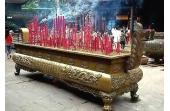Mount Emei
- Things to do
-
- Photo(15)
- Tips&article(16)
- Make it Happen
- Map
-
loading...
Mt. Emei in Sichuan Province in Southwest China is one of the most well-known summer destinations in China thanks to its pleasant weather, congenial atmosphere, the inspiring natural scenery and the influence of the Buddhist culture. The mountain is characterized by lofty ancient trees, impressive waterfalls, pristine brooks and numerous Buddhist temples.
Mt. Emei is noted for considerable weather difference between various spots on the mountain. A 14 centigrade degree difference in temperature has been reported between the foot of mountain and its peak. It's not uncommon for it to be blistering at the foot of the mountain and cool and pleasant higher up the mountain. The average temperature during July and August, the hottest period in China, is around 11.8 degree centigrade.
Mt. Emei is a natural "Oxygen Bar", where the average Negative Oxygen Ions in one cubic meter reach 0.1 million to 1 million which is 500-1000 times more than that in its city cousins. Scientists have confirmed that adequate negative oxygen ions (10.000 or above in one cubic meter air) in air can motivate the metabolization of the human body to repel exhaustion, improve sleep, and prolong life.
Mt. Emei is a sacred Buddhist haven. It is one of the four most divine Buddhism Mountains in China. This Buddhist legacy mainly contained in the numerous temples and the buildings bears witness to the unusual historical role of the mountain in Buddhism development since the religion was introduced to China over 2,000 years ago. The mountain enjoys great popularity among Buddhists in China. Every morning streams of Buddhism pilgrims armed with joss sticks conquer the steep stairs of the mountain and swarm into the countless temples.
The Mt. Emei not only provides physical space to travelers but affords a personal exposure to the intimacy of nature and China's Buddhism culture. A gnarled ancient tree, a winding stream, waterfall and a Buddhist temple will be a reminder of the resiliency of nature and pristine civilization.
Attractions
Baoguo Temple
The Baoguo Temple at the foot of the Mt. Emei is the largest temple on the Mt. Emei and the starting point for taking a tour of the Mt. Emei. The temple was built during the years of Wanli period in the Ming Dynasty. The horizontal tablet of "Baoguo Temple" was written by Emperor Kangxi of the Qing Dynasty.
It is the place where the Mt. Emei Buddhist Society is located. The Baoguo Temple is originally named Huizong Hall, which has the meaning of blending the three religions of Buddhism, Taoism and Confucianism into one. Emperor Kangxi of the Qing Dynasty granted the name of "Baoguo Temple", which adopts the meaning that dedicating to the service of the country comes first in "repaying four kindness" in the sutra.
The whole temple is a typical courtyard house covering an area of more than 10 acres. Each courtyard has one view and the scenery changes as you go deeper and deeper, which is rather a spectacular scene. The main hall of the temple built along the mountain has four layers with one layer higher than another, which presents a grand and natural appearance.
Wannian Temple
Wanian Temple is one of the eight largest temples on the Mountain. It was first built in the in the East Jin Dynasty and was renamed as White Water Puxian Temple after a series of devastation and reconstruction. The temple contains five halls lay in a tier style including the Mountain Gate, Buddha Miatreya Hall, Brick Hall, Wei'e Treasure Hall, the Treasure Hall of Great Hero.
The Brick Hall of the Wannian Temple is a wonder of ancient buildings. During the past four hundred years, it has gone through several earthquakes of magnitude 5 to 7.9 but it is still standing to this day. Hence, it is reputed as a miracle in the history of ancient architecture in China. A highlight of the temple is a bronze statue of Puxian riding an elephant, which was cast in Chengdu by a Buddhist monk named Maozhen under an imperial order during the Song Dynasty.
The bronze statue has a symmetrical proportion with superior casting craftwork. It is 7.85 meters high and weighs 62 tons. What How such a huge objective was transported and placed on the mountain remains a mystery.
Wannian Temple has cableway to mountain climbing and sightseeing areas like the Gold Summit. Many tourists take the Wannian Temple as the starting point for climbing the mountain while other tourists take it as the ending point for completing the tour of the mountain. The admission fee for this scenic point is 10 yuan. If tourists want to use cableway the cost is 40 yuan and 30 yuan for going down.
Qingyin Pavilion
Qingyin Pavilion was built by a Tang Dynasty Buddhist monk, whose Buddhism spiritualism exists today around the mountain. The pavilion presents a fine natural picture with pavilions, towers, corridors exquisitely combined with waters and hills.
Gold Summit
The number of the Buddhist temples dotting the mountain is quite inspiring but the views from the Golden Summit at an elevation of 3,077 meters above sea level steals the glory. The Gold Summit is an extravagance of natural wonders and Buddhism spiritualism, which comprise of four marvelous spectacles of Sunrise, Cloud Sea, Buddhist Light and sacred lamp.
The scenery of a red glowing sun dancing over the sea of clouds in the east is fabulous. A few lucky visitors will encounter the Buddhist Light which only occurs 14 times a year. On these occasions, your shadow is cast before you in the mist and a colorfully glowing lights circle you as if you are attained enlightenment.
Golden Buddha
The four-side ten-direction golden statue of Puxian on the Golden Summit of the Mt. Emei is the highest golden Buddha in the world and also the first artistic design of ten-direction statue of Puxian. The golden Buddha is a Buddhist statue built by employing the craftwork of copper casting and gold-plating.
It has a total height of 48 meters and a total weight of 660 tons. It is composed of the dado and ten-direction statue of Puxian. The golden Buddha's total height of 48 meters stands for 48 wishes of Amitable Buddha. "Ten-direction" firstly means ten practices and wishes of Puxian and secondly symbolizes the ten directions of east, south, west, north, southeast, southwest, northeast, northwest, up and down in Buddhism and means the boundless practices and wishes of Puxian can satisfy Buddha of ten directions and three lives and all living things.
The ten head sculptures of Puxian are composed of three layers with varied expressions, which stand for ten mentalities of earthlings.
Elephant Watching Pool
The Elephant Watching Pool has a height of 2070 meters above sea level. It has misty white clouds and ancient tall tress around. When the bright moon shines high in the sky in autumn, all is quiet with boundless pure light. Looking up at the sky, you will feel like an immortal. The "Night Moon over the Elephant Pool" is the famous sight here. At night when the bright moon is high in the sky and moonlight is reflected in the pool, the water and the sky are in one color with serene and beautiful scenery.
Tips & articles
|
|
|
forum discussion
|
|
|











